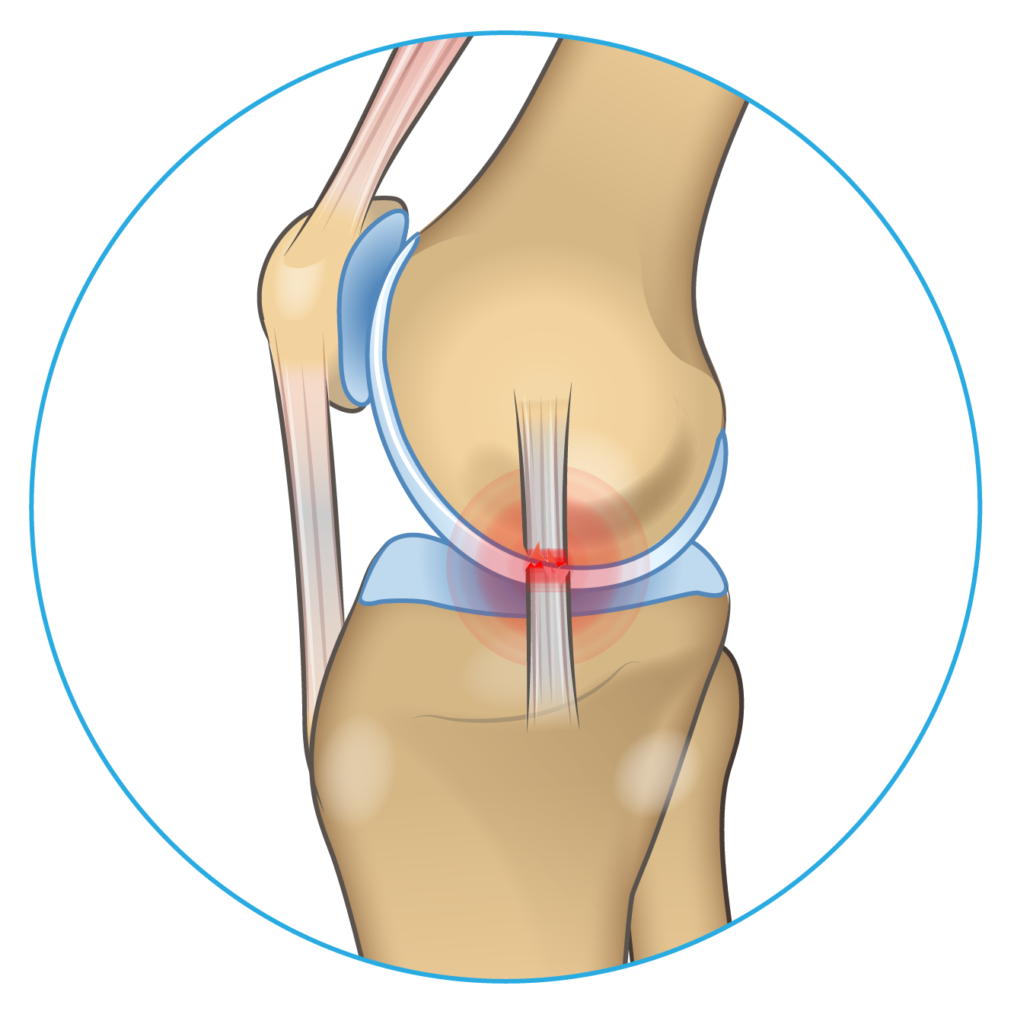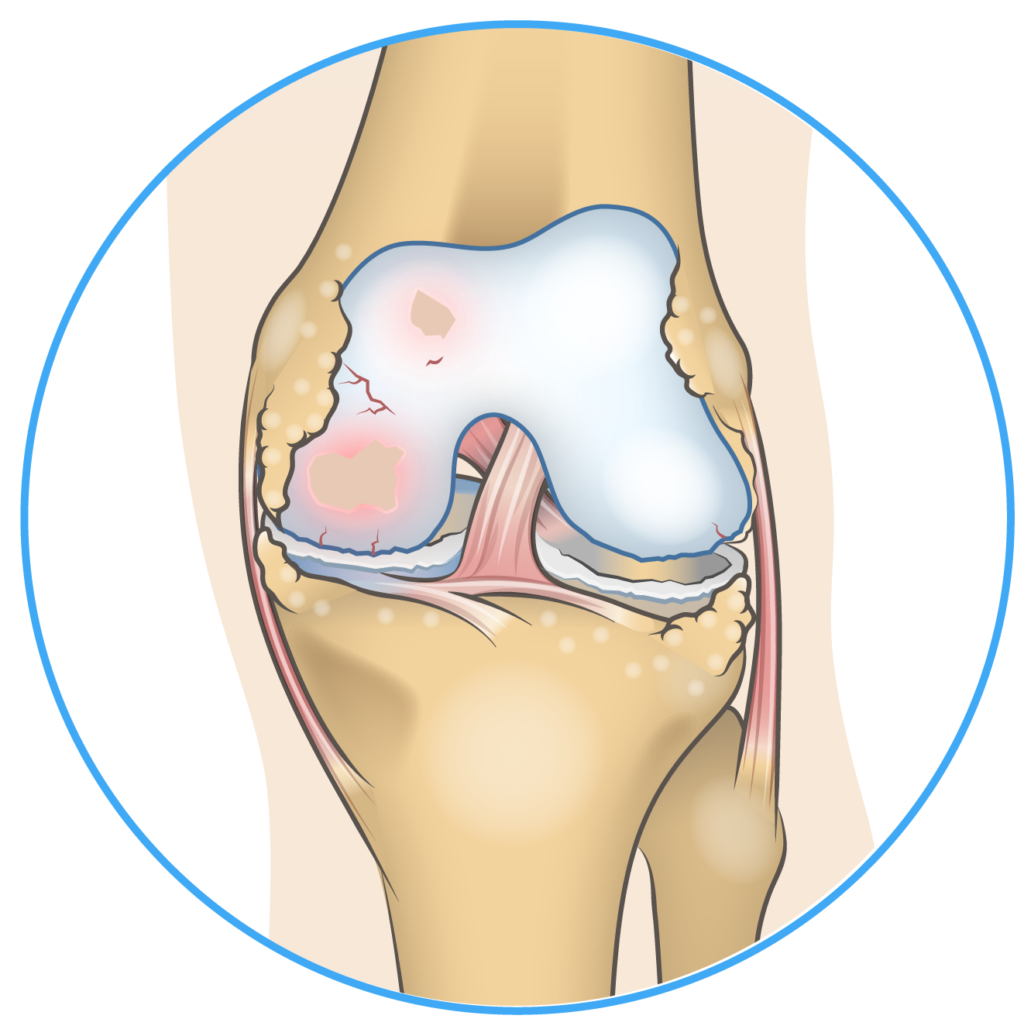Knee Pain on the Inside of Your Joint? Causes & Solutions

Do you have pain on the inside of your knee joint? Learn why and what you can do about it.

Over 25% of adults will experience persistent knee pain in their lifetimes.1 The inside (medial aspect) of the knee is a common area of discomfort. If you are experiencing pain in this area here are five common injuries that may be the culprit.
Knee Pain on the Inside – Five Common Injuries
Meniscus Irritation or Injury
The medial meniscus helps absorb weight as you move, particularly during high impact activities like running and jumping. It is often injured while playing sports. Unexpected collisions, stopping and starting at high speeds and twisting movements are the events that typically result in meniscal injury. Afterward, you may notice pain and swelling throughout the knee especially on the inside of the joint. You will also experience a loss in range of motion, and may feel like your knee is unstable while walking. If you have suffered a traumatic injury to your meniscus you should seek medical attention immediately. Depending on the nature of the tear, surgery may be warranted.
While traumatic meniscus injuries are common, it is also possible to irritate the meniscus through repetitive movements. Frequent squatting and bending while working, can over time, cause small fissures to develop in the meniscus resulting in nagging pain and instability. In these situations, an offloader knee brace can be a great treatment option. Because the brace actively reduces pressure on the joint, it will help keep you on your feet and working while letting your meniscus heal.
Pes Anserine Bursitis (PAB)
Bursae are small fluid-filled sacs that sit between bones, muscles, and tendons. They allow for proper joint function by reducing friction during movement. The Pes Anserine Bursa is located on the inside of the upper tibia (shin bone), just below the knee joint. Strain caused by over-exercising or poor biomechanics can cause it to become inflamed.2 Symptoms include tenderness, swelling, and pain on the inside of the knee. Typically PAB resolves with rest, physiotherapy, icing, and anti-inflammatory drugs.3
Synovial Plica Syndrome (SPS)
Plica are extremely thin sheets of viscous tissue that surround the knee joint. Sometimes this tissue can get in the way of normal joint movement causing impingement, which can be painful and reduce the range of motion of the joint. The plica on the inside of the knee is most commonly affected.4 Typically pain presents itself on the upper/inside area of the knee at 70-100 degrees of knee bend.4 Symptoms often begin without an obvious cause, although those with weak quadriceps muscles appear to be at higher risk.5 Episodes of pain are generally worsened by heavy physical activity or prolonged knee flexion such as when the leg is bent during sleep.5 Catching, popping, grinding, cracking, and instability are also commonly reported, making it tough to differentiate from other types of knee pain.6
Rest and activity modifications are commonly recommended for SPS. Temporarily avoiding lunging, squatting and high impact activity is also recommended. A tailored exercise regime prescribed by a physical therapist can help return the knee joint to normal function. In cases where exercise, rest and other conservative treatments have failed, surgery may be considered.5
Medial Collateral Ligament (MCL) Sprain/Strain

The MCL is an integral part of your knee joint – attaching the inside edge of the thigh bone to that of the shin bone. As inward stress is applied to the knee joint, the MCL helps resist strain and keep the joint stable. Sometimes the strain surpasses the strength of ligament causing it to partially tear or in more serious cases completely rupture. This injury is common in sports that involve tackling, and high impact athletic feats. In professional soccer, 70% of MCL injuries are due to contact with another player.7 Given the strength of the MCL, injuring it comes with immediate symptoms such as pain, swelling, inability to bear weight and instability.
- Grade I: The MCL has been overstretched, while there is no major damage, it’s function will be compromised until it has healed.
- Grade II: The MCL has been partially torn and may require surgery to repair depending on the extent of the damage.
- Grade III: A complete tear of the MCL requiring surgery to reconstruct the ligament.
Medial Knee Osteoarthritis (OA)

Arthritis is the most common cause of knee pain for those over the age of 50.1 Over 35% of knee arthritis diagnoses include degeneration in the medial compartment of the knee.7 As you age, the cartilage protecting your joint slowly erodes away. In arthritic knees this degeneration is advanced, exposing bone surfaces onto each other. This creates excessive friction during movement. Symptoms include grinding sensations, stiffness, and pain. There are four grades of osteoarthritis (I-IV) which can be diagnosed using x-ray imaging.
In medial knee OA, the arthritis is confined to the inside of your knee only. This means that the lateral and patellofemoral compartments on the outside of your knee and the kneecap may still be quite healthy. There are many treatment options at your disposal. Painkilling drugs, exercise, diet, knee braces, injections, and surgery are all viable options. If you are suffering from medial OA, surgery is considered a last resort – most doctors recommended exhausting your conservative treatment options first.9
What’s Next?
- Hopefully, this information has provided you with some insight as to what could be causing the pain on the inside of your knee. For more information on knee pain treatments visit our Complete Guide to Knee Pain
- If knee arthritis is the underlying cause of your knee pain check out:
References
- Nguyen, U. S. D., Zhang, Y., Zhu, Y., Niu, J., Zhang, B., & Felson, D. T. (2011). Increasing prevalence of knee pain and symptomatic knee osteoarthritis: survey and cohort data. Annals of internal medicine, 155(11), 725-732.
- Rennie, W. J., & Saifuddin, A. (2005). Pes anserine bursitis: incidence in symptomatic knees and clinical presentation. Skeletal Radiology, 34(7), 395–398. doi:10.1007/s00256-005-0918-7
- Sapp, G. H., & Herman, D. C. (2018). Pay Attention to the Pes Anserine in Knee Osteoarthritis. Current sports medicine reports, 17(2), 41.
- Griffith, C. J., & LaPrade, R. F. (2008). Medial plica irritation: diagnosis and treatment. Current reviews in musculoskeletal medicine, 1(1), 53-60.
- Lee, P. Y. F., Nixion, A., Chandratreya, A., & Murray, J. M. (2017). Synovial plica syndrome of the knee: a commonly overlooked cause of anterior knee pain. The Surgery Journal, 3(01), e9-e16.
- Bellary, S. S., Lynch, G., Housman, B., Esmaeili, E., Gielecki, J., Tubbs, R. S., & Loukas, M. (2012). Medial plica syndrome: a review of the literature. Clinical Anatomy, 25(4), 423-428.
- Lundblad, M., Waldén, M., Magnusson, H., Karlsson, J., & Ekstrand, J. (2013). The UEFA injury study: 11-year data concerning 346 MCL injuries and time to return to play. British Journal of Sports Medicine, 47(12), 759–762.doi:10.1136/bjsports-2013-092305
- Crawford, D. C., Miller, L. E., & Block, J. E. (2013). Conservative management of symptomatic knee osteoarthritis: a flawed strategy?. Orthopedic reviews, 5(1)
- K.S. Al-Obaedi, O. Shah, M. (2018). Prevalence of Compartmental Osteoarthritis of the Knee in an Adult Patient Population: A Retrospective Observational Study. EC Orthopaedics
Frequently Asked Questions
Pain on the inside of the knee may be due to irritation or injury in certain inner knee structures, such as the meniscus, air pockets (bursae), tissue sheets (plica), or ligaments. Medial knee arthritis may also cause pain on the inside of the joint.
Synovial plica syndrome (SPS) is an irritation of the thin sheets of tissue (plica) that line the knee joint. During movements, rubbing can occur between the plica and knee structures, resulting in pain.
Pes anserine bursitis (PBS) is the inflammation of the fluid-filled sacs (bursae) of the upper shin bone (tibia).
A medial collateral ligament (MCL) sprain is an injury to the ligament that connects the thigh bone to the shin bone.